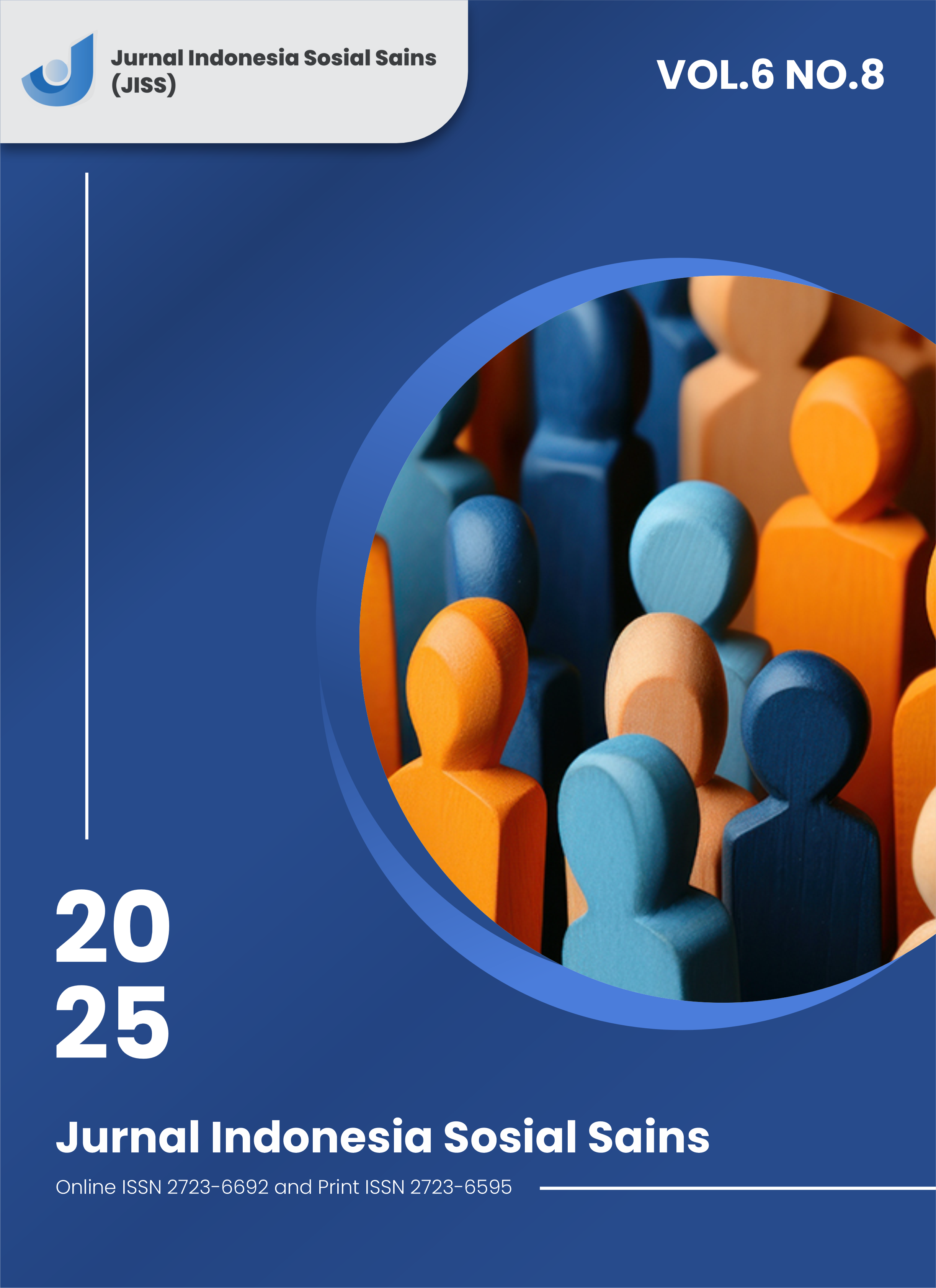Physiotherapy Management with Infrared, Transcutaneous Electrical Nerve Stimulation, and Nerve Tendon Gliding Exercise in Dextra Carpal Tunnel Syndrome Cases
DOI:
https://doi.org/10.59141/jiss.v6i8.1826Keywords:
Carpal Tunnel Syndrome Dextra, Infrared, Transcutaneus Electrical Nerve Stimulation and Nerve Tendon Gliding ExerciseAbstract
Carpal tunnel syndrome (CTS) is a peripheral nerve disease caused by compression of the median nerve in the carpal canal, where the canal is limited by the carpal bone and transverse ligament. Carpal tunnel syndrome arises when the median nerve is compressed within the channel of the wrist. Symptoms caused by CTS can lead to functional impairment of the hand, while most human work involves using the hands, resulting in disruption of daily activities. Therefore, managing CTS patients—one of which is through physiotherapy treatment—is important. Providing physiotherapy interventions using Infrared aims to improve blood circulation, reduce pain, and increase muscle relaxation; Transcutaneous Electrical Nerve Stimulation (TENS) aims to reduce pain, increase muscle strength, and improve hand function. This scientific paper is a case study, presenting patient cases and collecting data through the physiotherapy process. The modalities administered are Infrared, TENS, and Nerve Tendon Gliding Exercise. After physiotherapy was performed four times, the results showed a decrease in pain, a decrease in paraesthesia/tingling, an increase in the range of joint motion, an increase in muscle strength, and an improvement in functional activity ability as measured by the WHDI index. Physiotherapy management with Infrared, Transcutaneous Electrical Nerve Stimulation, and Exercise modalities performed over four therapy sessions in cases of Carpal Tunnel Syndrome Dextra can reduce pain and paraesthesia/tingling, increase the range of joint motion, enhance muscle strength, and improve functional activity as indicated by the WHDI index.
References
Anggraini, C., & Astari, R. W. (2021, November 24). Efektivitas wrist stretching, tendon and nerve gliding exercise dalam menurunkan nyeri dan meningkatkan fungsional wrist pada kasus carpal tunnel syndrome. Jurnal Health Sains, 2(11), 1434-1438.
Azizah, N. N., Putri, M. W., Hamzah, A., Studi, P., Fisioterapi, D. I., & Kalimantan, P. U. (2020). Penatalaksanaan fisioterapi pada gangguan nyeri akibat carpal tunnel syndrome dengan modalitas ultrasound dan carpal bone mobilization di Rumah Sakit Bhayangkara TK. III Banjarmasin.
Eschweiler, J., Li, J., Quack, V., Rath, B., Baroncini, A., Hildebrand, F., & Migliorini, F. (2022). Anatomy, Biomechanics, and Loads of the Wrist Joint. Life, 12(2), 188. https://doi.org/10.3390/life12020188
Fannysah Zahwa, F., & Widanti, H. N. (2024). Benefits of median nerve mobilization techniques to reduce pain and increase functional ability of the hand in patients with carpal tunnel syndrome: A case report study.
Handalguna, O. S., Rahayu, U. B., & Hidayati, A. (2022). Penatalaksanaan fisioterapi terhadap penurunan kemampuan fungsional pada kasus carpal tunnel syndrome (CTS) dextra. Jurnal Innovation Research and Knowledge, 2(7).
Kefis, & Ningsih, D. (2017). Penatalaksanaan fisioterapi dengan modalitas ultrasound (US) dan upper limb tension test 1 pada carpal tunnel syndrome dextra.
Lee, K.-S., & Jung, M.-C. (2015). Ergonomic Evaluation of Biomechanical Hand Function. Safety and Health at Work, 6(1), 9–17. https://doi.org/10.1016/j.shaw.2014.09.002
Malau, Unny Y., & Rahman, I. (2021). Penatalaksanaan fisioterapi pada kasus carpal tunnel syndrome dextra modalitas ultrasound, nerve and tendon exercise di RSAU Dr. M. Salamun Kota Bandung. Jurnal Kesehatan dan Masyarakat (Jurnal KeFis), 1(Oktober), 1-8.
Maratis, J., Guspriadi, E., Salim, C. H., et al. (2022). Penatalaksanaan fisioterapi kasus carpal tunnel syndrome pada pekerja kantoran. Jurnal Ilmiah Fisioterapi (JIF), 5.
Marryam, M., Yasmeen, R., Mehmood Malik, T., Malik, A. N., & Amjad, I. (2018). Neurodynamics versus nerve and tendon gliding exercised Pak Armed Forces Med. Journal, 68.
Martini, S., Sumitro, Putra, A., Aguscik, Jaya, H., Athiutama, A., et al. (2023). Peningkatan pengetahuan masyarakat tentang carpal tunnel syndrome (CTS) melalui penyuluhan dan deteksi dini penyakit pada pembuat pempek. Jurnal Salingka Abdimas, 3(1), 219-223.
Nur, S., & Khansa, K. (2019). Penatalaksanaan fisioterapi dengan infrared, ultrasound dan terapi latihan pada carpal tunnel syndrome dextra. Jurnal Ilmiah Widya, 5(3), 1-7.
Nurullita, U., Wahyudi, R., & Meikawati, W. (2023, April 7). Kejadian carpal tunnel syndrome pada pekerja dengan gerakan menekan dan berulang. Jurnal Kesehatan Vokasional, 8(1), 1.
Qomariyah, Q., Filmasari, F., Rania, R., Adelin, S. P., Dianingtyas, A. S., Kinanti, D. K. A., et al. (2023, June 7). Efektivitas transcutaneous (TENS), ultrasound (US) dan terapi latihan pada kondisi carpal tunnel syndrome (CTS). FISIO MU Physiotherapy Evidences, 4(3), 140-144.
Rizky, W. F. (2023, May). Penatalaksanaan fisioterapi dengan modalitas ultrasound dan transcutaneous electrical nerve stimulation pada carpal tunnel syndrome bilateral.
Sari Dewi, M. H. (2024). Penatalaksanaan fisioterapi pada keterbatasan aktivitas fungsional pada carpal tunnel syndrome: A case report. Journal Physical Therapy UNISA, 4(1), 1-9.
Simson, S., Ina, B., Marolop, P. N., Isa, H., et al. (2024). Penatalaksanaan fisioterapi pada kasus carpal tunnel syndrome di Rumah Sakit Efarina Etaham Pematangsiantar tahun 2024. Pematangsiantar.
Wahab, K. W., Sanya, E. O., Adebayo, P. B., Babalola, M. O., & Ibraheem, H. G. (2017). Carpal Tunnel Syndrome and Other Entrapment Neuropathies. Oman Medical Journal, 32(6), 449–454. https://doi.org/10.5001/omj.2017.87
Downloads
Published
How to Cite
Issue
Section
License
Copyright (c) 2025 Amanda Rilya Fressica, Suci Amanati

This work is licensed under a Creative Commons Attribution-ShareAlike 4.0 International License.
Authors who publish with this journal agree to the following terms:
- Authors retain copyright and grant the journal right of first publication with the work simultaneously licensed under a Creative Commons Attribution-ShareAlike 4.0 International. that allows others to share the work with an acknowledgement of the work's authorship and initial publication in this journal.
- Authors are able to enter into separate, additional contractual arrangements for the non-exclusive distribution of the journal's published version of the work (e.g., post it to an institutional repository or publish it in a book), with an acknowledgement of its initial publication in this journal.
- Authors are permitted and encouraged to post their work online (e.g., in institutional repositories or on their website) prior to and during the submission process, as it can lead to productive exchanges, as well as earlier and greater citation of published work.












